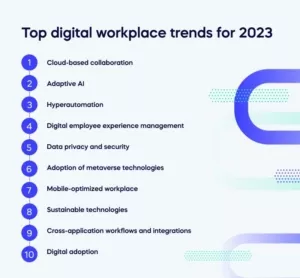Hybrid work models
Automating Workspaces: Trends Shaping the Future

Automating Workspaces: Trends Shaping the Future
Workplace automation is undergoing a transformative evolution, reshaping the way businesses operate and enhancing efficiency. In this article, we delve into the current trends in workplace automation, shedding light on the advancements that are shaping the future of work.
Rise of Robotic Process Automation (RPA)
Robotic Process Automation (RPA) is at the forefront of workplace automation trends. RPA involves using software robots or “bots” to automate repetitive and rule-based tasks. From data entry to invoice processing, RPA streamlines workflows, reduces errors, and allows employees to focus on more strategic and creative aspects of their roles.
Integration of Artificial Intelligence (AI) and Machine Learning (ML)
The integration of Artificial Intelligence (AI) and Machine Learning (ML) is a game-changer in workplace automation. AI and ML algorithms enable systems to learn from data, adapt to changing scenarios, and make intelligent decisions. From predictive analytics for employee performance to chatbots for customer service, the applications of AI and ML are diversifying across various business functions.
Workflow Automation for Increased Productivity
Workflow automation is becoming increasingly sophisticated, encompassing entire business processes. This trend involves the automation of end-to-end workflows, allowing for seamless collaboration between different departments. By reducing manual handovers and delays, workflow automation enhances overall productivity and accelerates time-to-market for products and services.
Employee Self-Service Portals
Empowering employees through self-service portals is a rising trend in workplace automation. These portals enable employees to access information, submit requests, and perform various HR-related tasks independently. Employee self-service not only enhances efficiency but also contributes to a more engaging and satisfying employee experience.
Digital Adoption Platforms (DAPs) for Skill Development
With the rapid evolution of technology, ensuring that employees can effectively use new tools and platforms is crucial. Digital Adoption Platforms (DAPs) guide users through software interfaces, providing real-time assistance and tutorials. As businesses adopt new technologies, DAPs are instrumental in reducing learning curves and fostering quick and effective skill development.
Internet of Things (IoT) for Smart Workspaces
The Internet of Things (IoT) is transforming workspaces into intelligent environments. Connected devices and sensors enable the gathering of data on workplace usage, temperature, and lighting conditions. This data-driven approach allows organizations to optimize office layouts, improve energy efficiency, and enhance the overall work environment.
Enhanced Security with Automation
Workplace automation trends are also addressing the growing importance of cybersecurity. Automated security systems use AI to detect and respond to potential threats in real-time. By continuously monitoring network activities and identifying anomalies, these systems strengthen overall cybersecurity measures, safeguarding sensitive data and ensuring compliance with industry regulations.
Hybrid Work Models and Virtual Collaboration Tools
The rise of remote and hybrid work models has accelerated the adoption of virtual collaboration tools. Workplace automation trends are focusing on creating seamless virtual environments, integrating video conferencing, project management, and communication tools. This ensures that teams can collaborate effectively regardless of their physical location.
Emphasis on Employee Well-Being and Experience
Automation is not only about tasks; it also extends to enhancing the overall employee experience. Workplace automation
